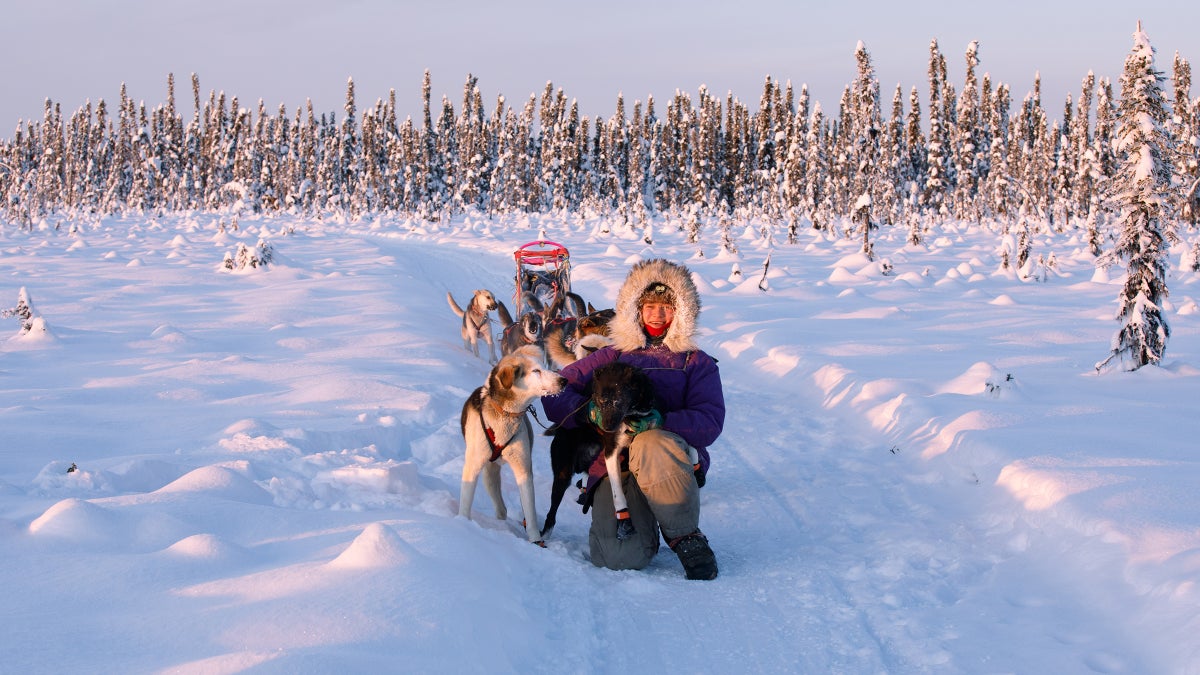No products in the cart.
Outdoor Adventure
Meet Apayauq Reitan, the First Trans Woman to Complete the Itidarod
Get full access to Outside Learn, our online education hub featuring in-depth fitness, nutrition, and adventure courses and more than 2,000 instructional videos when you
sign up for Outside+.
Pulled by seven dogs in pink-and-blue booties and carrying a pink, white, and blue trans pride flag, Iditarod competitor Apayauq Reitan drove her sled through the streets of Nome, Alaska, late at night on March 19. Spectators lined the streets to cheer on the 24-year-old Inupiaq musher as she completed her 13-day, nine-hour journey from Willow, Alaska. Her 37th-place finish earned her two accolades. One, the Red Lantern, is an award for coming in last. The second accomplishment was a landmark first: Reitan is now the first transgender woman to enter and complete the most famous dogsled race in North America.
The Red Lantern award is given in recognition of the grit required to be in the remote Alaskan wilderness in sub-zero temperatures for longer than any other musher in the 1,000-mile race. “It’s a symbol of perseverance and endurance,” Reitan said, explaining that the origins of the award dated back to when mail was delivered by dog team across rural Alaska. “They would carry a lantern, and when the last musher would come in off the trail they would turn off that lantern so that everyone would know that everyone was safely home.”
Though her family is from the Inupiat tribe in Alaska, Reitan was raised in Narjordet, Norway, where her dad—also a former Iditarod racer—kept a kennel at their home. She began competing in youth races at fifteen and has completed the Iditarod once before, in 2019. But this was the first race Reitan completed using the name Apayauq, as an out trans woman, instead of under the name she was given at birth and changed as part of her gender transition.
“That was part of the reason that I was running again, so that the world would know that I wasn’t cis,” Reitan told Outside, adding, “I wasn’t cis when I did it last time, either, it’s just that I was in the closet.”
But she wasn’t just running for individual reasons. “It’s not a very easy time for trans people right now,” she says, referencing the wave of anti-trans legislation being considered in statehouses across the country, much of it specifically targeting trans youth and trans athletes. These measures seek to criminalize providing trans people, particularly trans minors, with gender-affirming healthcare, prevent them from playing on the school sports team that aligns with their gender identity, and ban teachers from discussing LGBTQ+ identities in schools, among other things. In Alaska, where the Iditarod takes place, a bill that would prohibit trans girls from competing on sports teams with cis girls is currently working its way through the legislature.
On March 21, Reitan quipped on Twitter, “Defeating the ‘biological advantage of trans women’ narrative by being literally the slowest musher to finish the Iditarod this year.”

As part of her mission to increase trans visibility, Reitan invited a documentary filmmaker to accompany her during most of the race. “I think that it’s pretty incredible that I would finish with the Red Lantern while I had been making a documentary about my journey,” she says. “I’m just happy that maybe some trans people will see that I was able to finish the Iditarod. And I was out this time. Hopefully that will give some trans people, I don’t know, hope.”
Reitan faced different challenges racing this year than in 2019. She has been on HRT, a hormonal therapy commonly used in transgender people’s transitions, for six months. The hormone made Reitan more susceptible to the cold, and she suspects it made her lose some physical strength, too. But the mental payoffs more than made up for it.
“Emotionally, being on estrogen just feels right, like the correct hormone for me. It makes my emotions more clear, and a bit stronger. So I had a lot more happy moments in this Iditarod, and they were a lot more intense,” Reitan explained.
Reitan also felt she had more fortitude and resilience this year, which she needed. Each musher starts the race with 14 dogs, and it’s not uncommon for a team to shrink due throughout the race—mushers will leave injured or underweight dogs at various checkpoints throughout the race to recover. In 2019, Reitan finished with 11 dogs. But this year, at the halfway point, she had nine. She pulled into Nome with just seven. The smaller squad had to move more slowly and rest more frequently.
Part of the challenge for Reitan was that she was running a relatively young team, comprised mostly of yearling dogs in their first Iditarod who couldn’t run for as long without resting and were more prone to injury. A couple of her dogs, Apok and Kent, were veterans who had already covered thousands of miles with Reitan, including her first Iditarod in 2019. But the rest were dogs from fellow musher and 2018 Iditarod champion Joar Ulsom’s kennel, where Reitan worked in exchange for running Ulsom’s dogs in her team. Ulsom, who placed 11th overall this year, got the pick of the litter while Reitan took out his next-best dogs for their first-ever 1,000-mile race.
Reitan laughed as she described a conversation with her dad the night before the race, when she told him that she didn’t expect her team to hold a super competitive pace. “I was saying like, well, it doesn’t really matter, finishing is my most important goal. I even said, oh well, even if I got the Red Lantern I would be proud finishing. So maybe I jinxed myself.”
At the moment, Reitan doesn’t plan to enter another dogsled race. She’s busy splitting her time between Norway and Kaktovik, a town on the Arctic Ocean in far northern Alaska where her family now runs a polar bear viewing tour business. But she’s not ruling anything out.
“I would be unwise to say that I’m done with it, because people have a tendency to end up going again,” she says, laughing. “It’s sort of an addictive thing. It’s very hard to stop doing Iditarod if you’ve started. It’s a hard thing to describe, to do that with your dogs. It’s just an amazing achievement, to struggle that far, across all of this beautiful land.”

